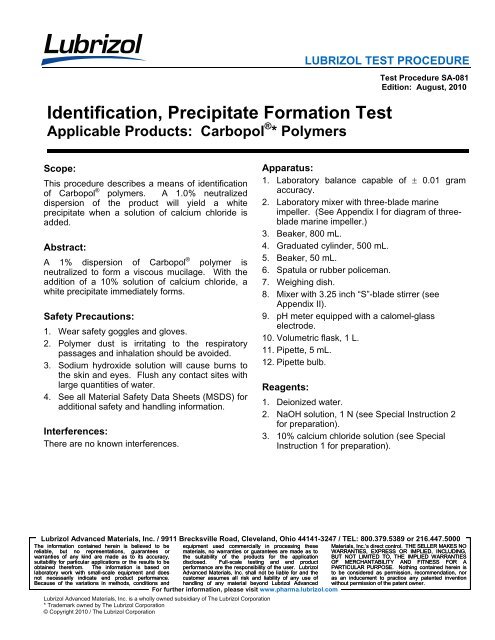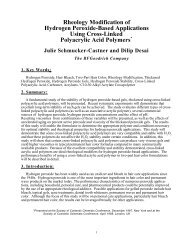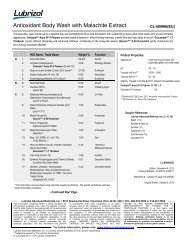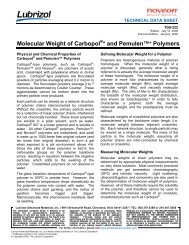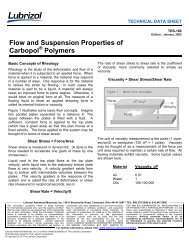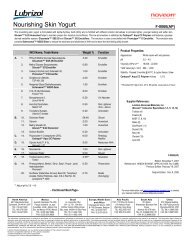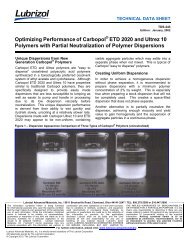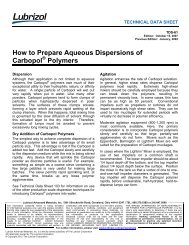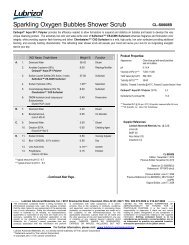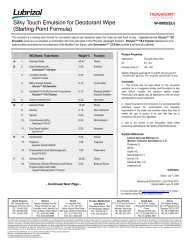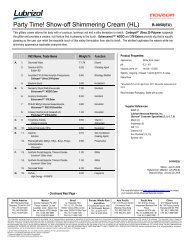Identification, Precipitate Formation Test - Lubrizol
Identification, Precipitate Formation Test - Lubrizol
Identification, Precipitate Formation Test - Lubrizol
You also want an ePaper? Increase the reach of your titles
YUMPU automatically turns print PDFs into web optimized ePapers that Google loves.
LUBRIZOL TEST PROCEDURE<br />
<strong>Identification</strong>, <strong>Precipitate</strong> <strong>Formation</strong> <strong>Test</strong><br />
Applicable Products: Carbopol ® * Polymers<br />
Scope:<br />
This procedure describes a means of identification<br />
of Carbopol ® polymers. A 1.0% neutralized<br />
dispersion of the product will yield a white<br />
precipitate when a solution of calcium chloride is<br />
added.<br />
Abstract:<br />
A 1% dispersion of Carbopol ® polymer is<br />
neutralized to form a viscous mucilage. With the<br />
addition of a 10% solution of calcium chloride, a<br />
white precipitate immediately forms.<br />
Safety Precautions:<br />
1. Wear safety goggles and gloves.<br />
2. Polymer dust is irritating to the respiratory<br />
passages and inhalation should be avoided.<br />
3. Sodium hydroxide solution will cause burns to<br />
the skin and eyes. Flush any contact sites with<br />
large quantities of water.<br />
4. See all Material Safety Data Sheets (MSDS) for<br />
additional safety and handling information.<br />
Interferences:<br />
There are no known interferences.<br />
<strong>Test</strong> Procedure SA-081<br />
Edition: August, 2010<br />
Apparatus:<br />
1. Laboratory balance capable of ± 0.01 gram<br />
accuracy.<br />
2. Laboratory mixer with three-blade marine<br />
impeller. (See Appendix I for diagram of threeblade<br />
marine impeller.)<br />
3. Beaker, 800 mL.<br />
4. Graduated cylinder, 500 mL.<br />
5. Beaker, 50 mL.<br />
6. Spatula or rubber policeman.<br />
7. Weighing dish.<br />
8. Mixer with 3.25 inch “S”-blade stirrer (see<br />
Appendix II).<br />
9. pH meter equipped with a calomel-glass<br />
electrode.<br />
10. Volumetric flask, 1 L.<br />
11. Pipette, 5 mL.<br />
12. Pipette bulb.<br />
Reagents:<br />
1. Deionized water.<br />
2. NaOH solution, 1 N (see Special Instruction 2<br />
for preparation).<br />
3. 10% calcium chloride solution (see Special<br />
Instruction 1 for preparation).<br />
<strong>Lubrizol</strong> Advanced Materials, Inc. / 9911 Brecksville Road, Cleveland, Ohio 44141-3247 / TEL: 800.379.5389 or 216.447.5000<br />
The information contained herein is believed to be equipment used commercially in processing these Materials, Inc.’s direct control. THE SELLER MAKES NO<br />
reliable, but no representations, guarantees or materials, no warranties or guarantees are made as to WARRANTIES, EXPRESS OR IMPLIED, INCLUDING,<br />
warranties of any kind are made as to its accuracy, the suitability of the products for the application BUT NOT LIMITED TO, THE IMPLIED WARRANTIES<br />
suitability for particular applications or the results to be disclosed. Full-scale testing and end product OF MERCHANTABILITY AND FITNESS FOR A<br />
obtained therefrom. The information is based on performance are the responsibility of the user. <strong>Lubrizol</strong> PARTICULAR PURPOSE. Nothing contained herein is<br />
laboratory work with small-scale equipment and does Advanced Materials, Inc. shall not be liable for and the to be considered as permission, recommendation, nor<br />
not necessarily indicate end product performance. customer assumes all risk and liability of any use of as an inducement to practice any patented invention<br />
Because of the variations in methods, conditions and handling of any material beyond <strong>Lubrizol</strong> Advanced without permission of the patent owner.<br />
For further information, please visit www.pharma.lubrizol.com<br />
<strong>Lubrizol</strong> Advanced Materials, Inc. is a wholly owned subsidiary of The <strong>Lubrizol</strong> Corporation<br />
* Trademark owned by The <strong>Lubrizol</strong> Corporation<br />
© Copyright 2010 / The <strong>Lubrizol</strong> Corporation
Procedure:<br />
1. With the mixer in the off position set the shaft<br />
angle at 60° and the mixer speed at 1000<br />
rpm.<br />
2. Measure 500 mL deionized water in a<br />
graduated cylinder and transfer to an 800 mL<br />
beaker.<br />
3. Place the beaker under the mixer with the<br />
impeller to one side of the beaker. The<br />
impeller should be as near the side and<br />
bottom of the beaker as possible (see Note<br />
1.)<br />
4. Weigh 5.00 g ± 0.01 g of the Carbopol ® ,<br />
polymer onto a weighing dish. This will yield<br />
a 1% dispersion in 500 mL water.<br />
5. Turn on the mixer and carefully begin to add<br />
the Carbopol ® polymer. Tilt the weighing<br />
dish and tap the side, causing the polymer to<br />
slowly sift into the water. Total addition time<br />
should be 45-90 seconds. CAUTION: If<br />
addition is too rapid, the polymer will<br />
agglomerate on the surface of the water.<br />
Incomplete hydration could influence the<br />
results of the test.<br />
6. Continue mixing for 15 minutes at approximately<br />
1000 rpm. Scrape any polymer from<br />
the sides of the beaker and stirrer shaft with<br />
a spatula or rubber policeman.<br />
7. Remove the dispersion from the mixer and<br />
allow to stand for 30 minutes to assure<br />
complete polymer hydration.<br />
8. Neutralize to a pH of approximately 7.5 with 1<br />
N NaOH.<br />
9. Use the “S”-blade stirrer to achieve a<br />
homogenous mucilage (see Note 2).<br />
10. Using a spatula, transfer approximately 10<br />
mL of the mucilage to a 50 mL beaker.<br />
11. Pipette 2 mL of a 10% calcium chloride<br />
solution to the 10 mL of mucilage.<br />
12. A white precipitate is immediately produced.<br />
<strong>Lubrizol</strong> <strong>Test</strong> Procedure SA-081<br />
Page 2 of 4<br />
Calculations:<br />
The result of the test is recorded as pass or fail.<br />
Special Instructions:<br />
1. Prepare 10% calcium chloride solution by<br />
adding 100 g calcium chloride to a one liter<br />
volumetric flask. Add 500 ml deionized<br />
water to hydrate the calcium chloride. Mix<br />
thoroughly. Fill to the mark with deionized<br />
water; invert several times to mix.<br />
2. Prepare 1 N NaOH solution by adding 40 g<br />
NaOH pellets to 500 mL deionized water in<br />
a 1 L volumetric flask. Mix thoroughly.<br />
After the solution has cooled, fill to the mark<br />
with deionized water, invert several times to<br />
mix. (Solution can be purchased).<br />
Notes:<br />
1. The angle of 60° and placement of the<br />
stirring shaft to one side of the beaker<br />
creates vigorous agitation with a minimum<br />
of vortexing.<br />
2. If the “S”-blade stirrer is not available, a<br />
spatula may be used to accomplish the<br />
mixing. At least two minutes of vigorous<br />
mixing is required to accomplish a<br />
homogeneous mucilage.<br />
References:<br />
• Current edition of the United States<br />
Pharmacopoeia/National Formulary (USP/NF)<br />
• Current edition of the European<br />
Pharmacopoeia
Appendix I<br />
Three-Blade Marine Impeller<br />
<strong>Lubrizol</strong> <strong>Test</strong> Procedure SA-081<br />
Page 3 of 4
Appendix II<br />
(Actual Size)<br />
“S”-Blade Impeller<br />
<strong>Lubrizol</strong> <strong>Test</strong> Procedure SA-081<br />
Page 4 of 4


